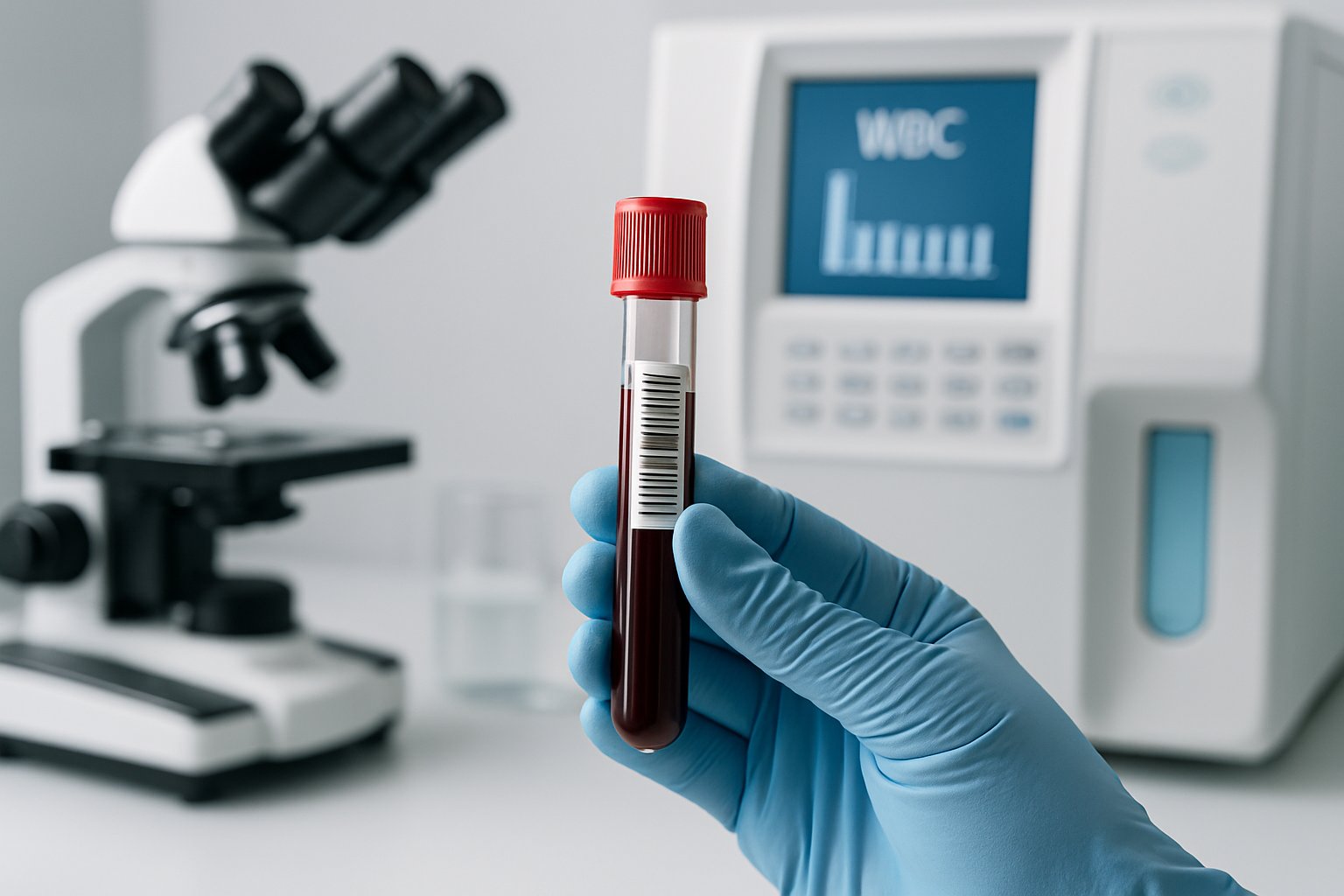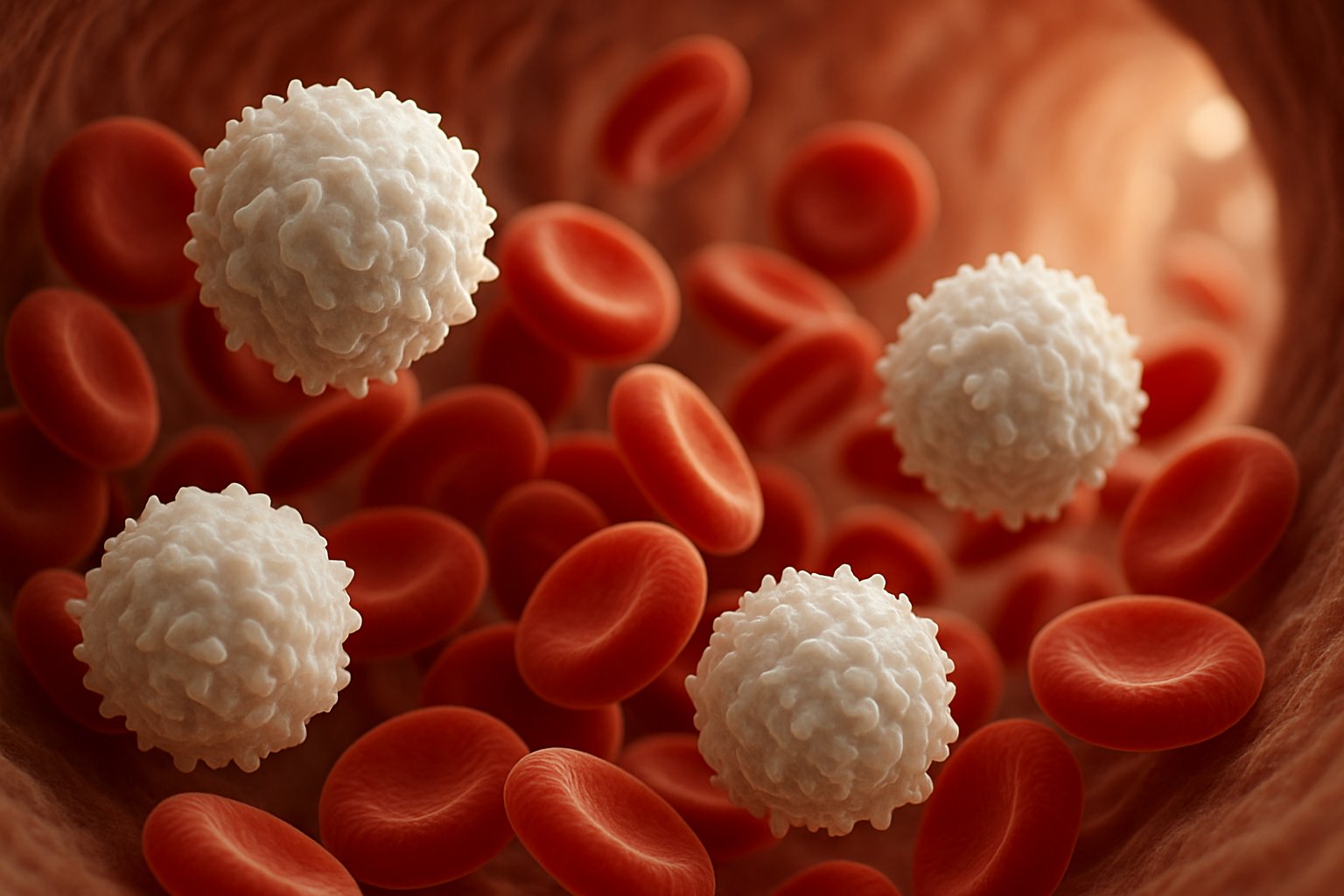When you get blood work done and see that your white blood cell count is high, it can be worrying. A high white blood cell count usually means your body is fighting an infection, dealing with inflammation, or responding to stress, though it can sometimes signal more serious conditions like blood cancers. Most of the time, elevated white blood cells indicate your immune system is working properly[1] to protect you from illness.

Doctors consider a white blood cell count high when it goes above 11,000 cells per microliter of blood. This condition is called leukocytosis. While high white blood cell counts can be caused by infections, cancer, and many other causes[2], the most common reasons are infections, allergic reactions, and physical stress on the body.
Understanding what causes high white blood cell counts and when to worry can help you make better decisions about your health. The good news is that most cases are temporary and resolve once the underlying cause is treated.
Key Takeaways
- High white blood cell counts typically indicate your immune system is fighting infection or inflammation
- Doctors diagnose leukocytosis when white blood cell counts exceed 11,000 cells per microliter of blood
- Treatment focuses on addressing the underlying cause rather than the high count itself
What Is a High WBC Count?

A high white blood cell count is called leukocytosis[2], which occurs when white blood cell levels exceed the normal range of 4,500 to 11,000 cells per microliter. Different types of white blood cells can be elevated depending on the underlying cause.
Definition of Leukocytosis
Leukocytosis is the medical term for an elevated white blood cell count in the blood. This condition develops when the body produces more white blood cells than usual in response to various triggers.
White blood cells help fight infection and aid in healing[2] from trauma or disease. When the immune system detects a threat, it signals the bone marrow to produce additional white blood cells.
The increased white blood cell production can cause several effects in the body. These include releasing enzymes that raise body temperature and cause fever. The cells also make blood vessels widen and become leaky, leading to redness and swelling.
Healthcare providers diagnose leukocytosis through blood tests. The condition itself is not a disease but rather a sign that something is affecting the immune system.
Normal vs. High WBC Levels
Normal white blood cell count ranges from 4,500 to 11,000 cells per microliter[2] of blood. Healthcare providers use these reference ranges to determine if a patient’s levels are within expected limits.
A white blood cell count exceeding 11,000 per microliter is considered high[3]. The severity depends on how far above normal the count rises and what is causing the elevation.
WBC Count Categories:
- Normal: 4,500-11,000 cells/μL
- Mild elevation: 11,000-15,000 cells/μL
- Moderate elevation: 15,000-25,000 cells/μL
- Severe elevation: Above 25,000 cells/μL
A complete blood count (CBC) test[1] measures white blood cell levels along with other blood components. This test provides the total WBC count and breaks down the different types of white blood cells present.
Types of High WBC Counts
The body produces five main types of white blood cells, and different conditions can cause specific types to increase. Each type has distinct functions in the immune system.
Neutrophils are the most common white blood cells and typically increase during bacterial infections. Lymphocytes rise during viral infections and certain cancers. Eosinophils elevate with allergic reactions and parasitic infections.
Monocytes increase during chronic infections and inflammatory conditions. Basophils are the least common and may rise during severe allergic reactions.
Healthcare providers examine which specific white blood cell types are elevated[2] to help determine the underlying cause. A peripheral blood smear can show if the cells have abnormal size or shape.
The pattern of elevation helps guide diagnosis and treatment decisions. Multiple types may be elevated simultaneously in some conditions.
How White Blood Cells Function in the Body

White blood cells serve as the body’s primary defense against infections and diseases, with each type performing specific functions within the immune system. These cells are produced in bone marrow and work together to protect against harmful invaders.
Role in the Immune System
White blood cells help your immune system protect your body against infection[4] by identifying and destroying harmful substances. These cells patrol the bloodstream and tissues looking for viruses, bacteria, and other threats.
When the body detects an infection, white blood cells quickly multiply and travel to the affected area. They release special chemicals that kill germs and help heal damaged tissue.
The immune system relies on white blood cells to remember past infections. This memory helps the body respond faster when it encounters the same threat again.
White blood cells also help remove dead cells and waste products from the body. They keep tissues clean and healthy by clearing away debris.
Types of White Blood Cells
The body produces five main types of white blood cells, each with different jobs. Neutrophils make up about 60% of all white blood cells and fight bacterial infections.
Lymphocytes include B cells and T cells that create antibodies and destroy infected cells. B cells produce antibodies that stick to germs and mark them for destruction.
Monocytes turn into larger cells called macrophages that eat germs and dead tissue. They clean up infection sites and help start the healing process.
Eosinophils fight parasites and play a role in allergic reactions. They release toxic substances that kill larger invaders like worms.
Basophils release histamine during allergic reactions and help coordinate immune responses. They make up less than 1% of white blood cells but have important functions.
White Blood Cell Production
Bone marrow produces all types of white blood cells through a process called hematopoiesis. Stem cells in the bone marrow divide and develop into different blood cell types.
The body makes about 100 billion white blood cells each day. Production increases when fighting infections or dealing with stress on the immune system.
White blood cells have short lifespans, typically lasting only days to weeks. The bone marrow must constantly replace them to maintain proper immune function.
Hormones and growth factors control how many white blood cells the body produces. The immune system sends signals to increase production when more cells are needed.
Common Causes of High WBC Count

Several factors can cause white blood cell counts to rise above normal levels. The most common triggers include bacterial and viral infections, inflammatory conditions like rheumatoid arthritis, certain medications, and in rare cases, blood cancers such as leukemia.
Infections
Bacterial infections represent the most frequent cause of elevated white blood cell counts. When harmful bacteria enter the body, the immune system responds by producing more neutrophils to fight the infection.
Common bacterial infections that raise WBC counts include pneumonia, urinary tract infections, and skin infections. The body typically produces thousands of additional white blood cells within hours of detecting these threats.
Viral infections also trigger increases in white blood cell production, though usually to a lesser degree than bacterial infections. Conditions like the flu, common cold, and mononucleosis can cause lymphocyte levels to rise.
Parasitic infections create another pathway for elevated WBC counts. When parasites invade the body, eosinophils increase significantly to combat these organisms. This response is particularly common with intestinal parasites and certain tropical diseases.
Inflammation and Autoimmune Conditions
Chronic inflammation causes the immune system to remain in an active state, leading to consistently higher white blood cell production. This response occurs even when no actual infection is present.
Autoimmune disorders create particularly complex patterns of elevated WBC counts. In these conditions, the immune system mistakenly attacks healthy tissue, triggering ongoing inflammatory responses.
Rheumatoid arthritis patients frequently show elevated white blood cell counts due to chronic joint inflammation. The condition causes persistent immune system activation that keeps WBC levels above normal ranges.
Lupus affects multiple organ systems and creates widespread inflammation throughout the body. This autoimmune disease often causes fluctuating WBC counts that correspond with disease flare-ups.
Other autoimmune conditions like inflammatory bowel disease and multiple sclerosis can also maintain elevated white blood cell levels through similar inflammatory mechanisms.
Blood Cancers and Bone Marrow Disorders
Blood cancers represent rare but serious causes[1] of extremely high white blood cell counts. These conditions affect the bone marrow where white blood cells are produced.
Leukemia causes the bone marrow to produce abnormal white blood cells in massive quantities. These cells don’t function properly but continue multiplying uncontrollably.
Lymphoma affects the lymphatic system and can cause specific types of white blood cells to increase dramatically. Both Hodgkin’s and non-Hodgkin’s lymphoma can create these patterns.
Other bone marrow disorders like myelofibrosis and polycythemia vera can also disrupt normal white blood cell production. These conditions often require specialized treatment to manage WBC levels effectively.
Medications and Lifestyle Factors
Several medications can artificially elevate white blood cell counts as side effects of their primary therapeutic actions.
Corticosteroids and other steroid medications commonly cause WBC increases. These drugs affect immune system function and can maintain elevated counts for extended periods.
Chemotherapy drugs often cause initial increases in white blood cell production before ultimately suppressing the immune system. The timing and duration of these effects vary significantly.
Some diuretics and antibiotics can also trigger temporary increases in WBC counts through various mechanisms.
Lifestyle factors play important roles in white blood cell regulation. Chronic stress causes cortisol release that can keep WBC counts elevated over time.
Smoking creates ongoing inflammation in the lungs and airways, leading to consistently higher white blood cell production. This effect persists as long as smoking continues.
Physical trauma, intense exercise, and extreme temperatures can also cause temporary spikes in white blood cell counts as the body responds to these stressors.
Recognizing Symptoms and When to Seek Medical Attention

High white blood cell counts often cause specific symptoms that range from mild to severe. Some symptoms require immediate medical care, while others develop due to the underlying condition causing the elevated count.
General Symptoms Associated with High WBC
Fever occurs as the body’s natural response[5] to infection or inflammation, which commonly causes high white blood cell counts. This is often the first symptom people notice.
Fatigue and weakness affect many patients with elevated WBC counts. The body uses extra energy to produce more white blood cells and fight whatever is causing the increase.
Common early symptoms include:
- Low-grade to high fever
- General tiredness that doesn’t improve with rest
- Muscle weakness
- Body aches
Night sweats may occur as the immune system works harder than normal. Some patients also experience headaches due to the body’s inflammatory response.
These symptoms often develop gradually over several days. They may come and go depending on what’s causing the high white blood cell count.
Red Flag Symptoms to Watch For
Certain symptoms with high WBC counts need immediate medical attention. These warning signs may indicate serious underlying conditions that require prompt treatment.
Seek emergency care for:
- High fever over 101°F (38.3°C)
- Unexplained weight loss of 10 pounds or more
- Easy bruising without injury
- Unusual bleeding from gums or nose
Frequent infections that don’t respond to normal treatment also signal a serious problem. This includes infections that return quickly after treatment or take longer than usual to heal.
Severe fatigue that prevents normal daily activities warrants medical evaluation. Night sweats that soak clothing or bedding repeatedly also require attention.
These symptoms may indicate blood cancers or other serious conditions. Early medical care improves treatment outcomes significantly.
Symptoms Linked to Underlying Causes
Different conditions that cause high WBC counts produce specific symptom patterns. Bacterial infections typically cause fever, fatigue, and symptoms related to the infection site.
Infection-related symptoms:
- Fever with chills
- Pus or drainage from wounds
- Localized pain and swelling
- Increased heart rate
Blood disorders may cause unusual bleeding, easy bruising, and severe fatigue. Patients often notice small red spots on their skin or bleeding that won’t stop.
Inflammatory conditions produce joint pain, muscle aches, and general body stiffness. These symptoms often worsen in the morning or after periods of rest.
Some medications cause high WBC counts along with side effects like nausea or skin changes. Allergic reactions may produce rash, itching, and breathing difficulties alongside elevated white blood cell levels.
Understanding these patterns helps patients and doctors identify the underlying cause more quickly.
Diagnosing the Reason for a High WBC Count

Doctors use specific blood tests and medical procedures to find out why white blood cell counts are elevated. The process starts with detailed lab work and may include bone marrow tests if needed.
Laboratory Tests and Investigations
A complete blood count (CBC) is the first test doctors order when checking for high white blood cell counts[1]. This test measures all types of blood cells in the body.
The CBC shows the total number of leukocytes per microliter of blood. Normal WBC counts stay below 11,000 cells per microliter.
Doctors also check other blood markers during testing. These include:
- Red blood cell count
- Platelet levels
- Hemoglobin amounts
- Blood chemistry panels
Blood smear tests let doctors see the actual shape and size of white blood cells under a microscope. This helps spot abnormal cells that might indicate blood cancer or other serious conditions.
Repeat blood tests help track changes over time. Doctors may order tests several days or weeks apart to see if WBC counts stay high or return to normal.
Assessment of WBC Subtypes
There are five main types of white blood cells, and each one can become elevated for different reasons. Doctors break down the total WBC count to see which specific types are high.
Neutrophils make up most white blood cells and fight bacterial infections. High neutrophil counts often point to bacterial infections or tissue damage.
Lymphocytes protect the lymphatic system and fight viruses. Elevated lymphocytes may suggest viral infections or certain blood cancers.
Monocytes boost immune responses against infections. High monocyte levels can indicate chronic infections or inflammatory conditions.
Eosinophils fight parasites and cause allergic reactions. Elevated eosinophils often relate to allergies, asthma, or parasitic infections.
Basophils are the rarest type and help with allergic responses. High basophil counts may suggest allergic reactions or rare blood disorders.
Additional Diagnostic Procedures
When basic blood tests don’t explain high WBC counts, doctors may order more advanced testing. These procedures help rule out serious conditions like blood cancer.
Bone marrow biopsy involves taking a small sample of bone marrow tissue. This test shows how white blood cells develop and can detect blood cancers or bone marrow disorders.
Doctors may also order flow cytometry tests. These tests examine white blood cell proteins to identify abnormal or cancerous cells.
Imaging studies like CT scans or ultrasounds help find infections, tumors, or enlarged organs. These scans show if high WBC counts relate to problems in specific body areas.
Genetic testing checks for chromosome changes in white blood cells. This testing helps diagnose certain types of leukemia or other blood disorders that cause elevated WBC counts.
Complications and Health Risks of Persistently High WBC

When white blood cell counts remain elevated over time, serious complications can develop that affect multiple body systems. A dangerous white blood cell count[3] can lead to blood clotting problems and widespread inflammation throughout the body.
Potential Complications
Blood Clots represent one of the most serious immediate risks. High white blood cell counts can make blood thicker and more likely to form clots in blood vessels. These clots can block blood flow to vital organs.
Chronic Inflammation develops when the immune system stays overactive for long periods. This ongoing inflammation damages healthy tissues and organs throughout the body.
Disseminated Intravascular Coagulation (DIC) is a life-threatening condition. The blood forms clots throughout small blood vessels while also bleeding excessively. This happens because clotting proteins get used up too quickly.
Organ Dysfunction occurs when high white blood cell counts interfere with normal organ function. The spleen, liver, and kidneys are often affected first. White blood cells can clog small blood vessels in these organs.
Infection Complications may seem backward, but very high white blood cell counts can actually make infections worse. The immune system becomes less effective when it is overworked.
Risks of Untreated Elevated WBC Count
Ignoring persistently high white blood cell counts allows underlying conditions to progress unchecked. High white blood cell counts can indicate serious conditions[2] that require immediate medical attention.
Progression of Blood Cancers like leukemia can accelerate rapidly without treatment. Cancer cells continue multiplying and crowding out healthy blood cells. This leads to severe anemia and bleeding problems.
Cardiovascular Complications develop as thick blood strains the heart and blood vessels. Heart attacks and strokes become more likely when blood cannot flow properly.
Immune System Exhaustion happens when white blood cells work too hard for too long. The body becomes unable to fight off even simple infections effectively.
Lymphocytosis complications include enlarged lymph nodes and organs. When lymphocytes multiply excessively, they can crowd organs and interfere with normal functions.
Treatment and Management of High WBC Count
Treatment for high white blood cell count[1] focuses on addressing the root cause rather than just lowering the numbers. Medical interventions range from simple medications to complex procedures, while lifestyle changes can support recovery.
Treating the Underlying Cause
Doctors first identify what caused the high white blood cell count before starting treatment. Infections are the most common reason for elevated WBC levels.
Bacterial infections typically require antibiotics to eliminate the harmful bacteria. The specific antibiotic depends on the type of bacteria causing the infection.
Viral infections usually resolve on their own without medication. However, doctors may prescribe antiviral drugs for severe cases like influenza or herpes.
Inflammatory conditions such as rheumatoid arthritis or inflammatory bowel disease need anti-inflammatory treatments. These may include corticosteroids or other immune-suppressing medications.
Cancer-related high WBC counts require oncology treatment. This might involve chemotherapy, radiation therapy, or targeted cancer drugs depending on the specific type of cancer.
Allergic reactions causing elevated white blood cells respond well to antihistamines and avoiding the allergen. Severe allergic reactions may need emergency treatment with epinephrine.
Medications and Medical Interventions
Several medications can help manage high white blood cell counts depending on the underlying condition. Corticosteroids like prednisone reduce inflammation and can quickly lower WBC levels.
For blood cancers like leukemia, chemotherapy drugs target and destroy abnormal white blood cells. These treatments are carefully monitored by oncologists.
Leukapheresis is a specialized procedure that removes excess white blood cells from the blood. This treatment is used when WBC counts reach dangerously high levels above 100,000 cells per microliter.
Some patients may need diuretics if fluid retention occurs alongside high white blood cell counts. These medications help remove excess fluid from the body.
Radiation therapy can target specific areas where abnormal white blood cells accumulate, particularly in certain types of blood cancers.
Immunosuppressive drugs may be prescribed for autoimmune conditions that cause elevated WBC counts. These medications help calm an overactive immune system.
Lifestyle Modifications
Patients can support their treatment through several lifestyle changes. Getting adequate rest helps the immune system function properly and recover from illness.
Vitamin D supplementation may benefit some patients, as this vitamin plays a role in immune system regulation. However, patients should consult their doctor before taking supplements.
Staying hydrated is important, especially when taking medications that can affect kidney function. Drinking plenty of water helps the body process medications and remove toxins.
A balanced diet rich in fruits and vegetables provides nutrients that support immune system health. Avoiding processed foods and excessive sugar can reduce inflammation.
Regular hand washing and avoiding sick people helps prevent additional infections. This is especially important for patients with compromised immune systems.
Stress management techniques like meditation or gentle exercise can help reduce inflammation in the body. Chronic stress can worsen many conditions that cause high WBC counts.
When Hospitalization Is Needed
Some situations require immediate hospital care for patients with high white blood cell counts. Extremely high counts above 50,000 cells per microliter often need inpatient monitoring.
Patients showing signs of infection with fever, chills, or difficulty breathing may need IV antibiotics in the hospital. This allows doctors to monitor their response to treatment closely.
Leukapheresis procedures typically require hospitalization because they involve removing and filtering large amounts of blood. This process can take several hours and needs medical supervision.
Severe dehydration or organ dysfunction related to high WBC counts necessitates hospital treatment. Patients may need IV fluids or other supportive care.
Cancer patients receiving intensive chemotherapy or radiation therapy often stay in the hospital for monitoring. These treatments can cause serious side effects that require immediate medical attention.
Blood clotting problems or bleeding complications may develop when WBC counts are very high. Hospital care ensures quick treatment if these dangerous complications occur.
Prevention and Monitoring
Regular blood tests help doctors track WBC changes and catch problems early. Simple lifestyle choices can help prevent WBC count spikes from infections and other causes.
Monitoring WBC Count Over Time
Doctors use a complete blood count (CBC)[1] to check WBC levels regularly. This test shows if white blood cells stay normal or change over time.
People with past high WBC counts need follow-up testing. The timing depends on what caused the first high reading.
Common monitoring schedules include:
- Every 2-4 weeks for active infections
- Every 3-6 months for chronic conditions
- Yearly for routine health checks
Patients should track symptoms between tests. Fever, fatigue, or unusual bleeding needs immediate medical attention.
Some medications require more frequent CBC monitoring. Blood thinners and immune system drugs can affect WBC count quickly.
Preventing Elevation of WBC Count
Good hygiene prevents many infections that raise WBC count. Washing hands often stops germs from spreading.
Key prevention steps include:
- Getting recommended vaccines on schedule
- Eating a balanced diet with fruits and vegetables
- Getting enough sleep each night
- Managing stress through exercise or relaxation
- Avoiding sick people when possible
Chronic conditions need proper management to prevent WBC spikes. Taking prescribed medications as directed helps control inflammation.
People should avoid smoking and limit alcohol. Both can weaken the immune system and cause inflammation.
Regular exercise boosts overall health but should not be excessive. Too much intense activity can temporarily raise white blood cell counts.
Associated Conditions: High vs. Low WBC Count
White blood cell counts outside the normal range signal different health problems. Low white blood cell counts[6] create immune system weakness, while elevated levels indicate active immune responses to infections or diseases.
Leucopenia and Its Implications
Leucopenia occurs when white blood cell levels drop below 4,000 cells per microliter. This condition weakens the body’s ability to fight infections and diseases.
Common causes of leucopenia include:
- Bone marrow disorders
- Autoimmune diseases like lupus[6]
- Chemotherapy treatments
- HIV infections[6]
- Certain medications
People with leucopenia face higher risks of serious infections. Even minor cuts or common colds can become dangerous.
The immune system cannot respond properly to threats. Bacterial and viral infections may spread quickly throughout the body.
Doctors monitor patients with low white blood cell counts[3] closely. Treatment focuses on addressing the underlying cause while protecting against infections.
Comparing Elevated and Decreased WBC Levels
High and low white blood cell counts create opposite health challenges. Each condition requires different medical approaches and monitoring strategies.
| High WBC Count | Low WBC Count |
|---|---|
| Immune system overactive | Immune system weakened |
| Fighting infections/inflammation | Cannot fight infections properly |
| Body producing too many cells | Body not producing enough cells |
| May indicate leukemia or infection | May indicate bone marrow problems |
High white blood cell counts[3] above 11,000 cells per microliter suggest active immune responses. The body produces extra cells to combat threats.
Low counts below 4,000 cells per microliter indicate compromised immunity. Patients need protective measures to avoid exposure to germs.
Both conditions require medical evaluation. Doctors use additional tests to determine specific causes and appropriate treatments.
Frequently Asked Questions
High white blood cell counts raise specific concerns about danger levels, cancer connections, and treatment options. Understanding normal ranges and symptoms helps people recognize when medical attention becomes necessary.
What levels of white blood cells are considered dangerous?
A white blood cell count above 11,000 per microliter is considered high[2]. Normal ranges fall between 4,500 to 11,000 white blood cells per microliter.
Extremely high counts above 50,000 per microliter often indicate serious conditions. These levels may require immediate medical attention.
The danger level depends on the underlying cause. Cancer-related high counts pose greater risks than infection-related increases.
Which types of cancer are associated with elevated white blood cell counts?
Leukemia and Hodgkin’s disease are cancers commonly linked to high white blood cell counts[2]. These blood cancers affect bone marrow where white blood cells form.
Bone marrow cancers cause overproduction of abnormal white blood cells. These cells cannot fight infections properly despite their high numbers.
Other blood cancers like lymphoma may also raise white blood cell levels. Solid tumors rarely cause significant white blood cell increases.
At what threshold might a high white blood cell count necessitate hospitalization?
Hospitalization depends more on symptoms than specific numbers. Patients with counts above 100,000 per microliter often need immediate care.
Emergency signs include high fever above 103 degrees, difficulty breathing, or severe weakness. These symptoms combined with high counts require urgent treatment.
Blood cancer patients may need hospitalization at lower counts. Their abnormal cells increase infection risks even with elevated numbers.
What are common methods to reduce an elevated white blood cell count?
Treating the underlying condition usually lowers white blood cell counts naturally. Antibiotics help reduce counts caused by bacterial infections.
Chemotherapy or radiation therapy treats blood cancers[2] that cause high white blood cell production. These treatments target abnormal cell growth.
Steroids or immunosuppressants help with autoimmune diseases[2] that trigger white blood cell increases. Anti-inflammatory medications may also help.
Stopping medications that raise white blood cell counts can normalize levels. Corticosteroids and lithium are common culprits.
What treatments are available for individuals with a high WBC count?
Treatment focuses on the root cause rather than the count itself. Viral infections often resolve without specific treatment beyond rest.
Bone marrow transplants may be necessary for some blood cancers[2]. This procedure replaces diseased bone marrow with healthy cells.
Supportive care includes fever reducers and pain medications. These treatments help manage symptoms while addressing underlying conditions.
Long-term autoimmune conditions require ongoing medication management. Regular monitoring ensures treatments remain effective.
What symptoms might indicate a high white blood cell count?
Fever, fatigue, and decreased appetite are common symptoms[2] associated with high white blood cell counts. These signs often accompany infections or inflammation.
Cancer-related high counts may cause night sweats, weight loss, and easy bruising[2]. Swollen lymph nodes in the neck, armpits, or groin also occur.
Respiratory symptoms include wheezing, congestion, or allergy-like reactions. Joint pain and swelling may develop with autoimmune causes.
Many people with high white blood cell counts feel no symptoms at all. Blood tests often detect elevated levels during routine checkups.
References
- Leukocytosis (High White Blood Cell Count): Causes & Symptoms. https://my.clevelandclinic.org/health/diseases/17704-high-white-blood-cell-count Accessed November 1, 2025
- high white blood cell counts can be caused by infections, cancer, and many other causes. https://www.verywellhealth.com/high-white-cell-count-5222110 Accessed November 1, 2025
- What Is a Dangerous White Blood Cell Count?. https://www.emedicinehealth.com/what_is_a_dangerous_white_blood_cell_count/article_em.htm Accessed November 1, 2025
- White Blood Cells: Types, Function & Normal Ranges. https://my.clevelandclinic.org/health/body/21871-white-blood-cells Accessed November 1, 2025
- What If My White Blood Cell Count Is High?. https://www.acibademhealthpoint.com/what-if-my-white-blood-cell-count-is-high/ Accessed November 1, 2025
- White Blood Count (WBC): MedlinePlus Medical Test. https://medlineplus.gov/lab-tests/white-blood-count-wbc/ Accessed November 1, 2025
